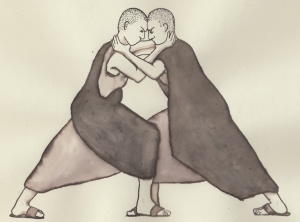“I believe that Gandhi’s views were the most enlightened of all the political minds in our time. We should strive to do things in his spirit: not to use violence in fighting for our cause, but by non-participation in anything you believe is evil.” –Albert Einstein
My goal is to write a short essay on each yama and niyama as it relates to our responsibility to act against climate disruption. But I’ve been a bit put off from starting by ahimsa (non-harming), because it seems too obvious somehow. Spelling out how non-harming relates to climate action has seemed like a boring topic. But maybe I can find a little more to it than ‘Everybody! Stop harming!’ Some behaviors cause obvious harm, and we avoid them. But the practice of ahimsa includes a higher standard as well: an untiring curiosity about harm-reduction.
Each action begins with a thought, so one subtle work of ahimsa is of ceasing to bully or punish yourself. This is as evident in activist work as it is in physical practice and observance of yoga’s ethical foundations: in order to sustain ourselves for the long path ahead, we respect our limits, our health, the limits and health of others.
We have known opponents in the climate struggle: fossil fuel industry executives, logging corporate folk, government subsidizers, those working in the action-stalling and denial industry. We need to work against them, strongly and quickly. Ahimsa is also the practice of opposing harmful actions while cultivating compassion for all actors. Nothing budges for the better without the lubricant of love. It becomes easier to identify with and forgive other people for their harmful actions as you dig into your own inner workings and discover the contrary impulses, aggression directed both in and out, the thousand carefully constructed defenses we all contain.
How do you greet these self-discoveries? My own impulse has often been a puritanical scrubbing and a hasty disavowal, but in the spirit of ahimsa, the more skillful strategy might be the meditation mantra of candor: ‘So Hum’- I am that. As we give, so we receive.
We yogis often feel encouraged to love everyone, to find ourselves in even the people we find most trying or despicable. And this, in practice, is often frustrating and nearly impossible, especially when you’re actually interacting with that person, not just thinking of them remotely. In climate action circles we can often get hung up on others’ shortcomings, which is another quick way to get angry and discouraged. When we turn to ourselves in contemplation and close observation, and do it in this non-violent way, what we may find is grounds for connection. Several times this week I deleted emails or text messages I was composing, or refrained from saying something out loud because I could tell that my reasons for saying it were not clear to me or were not good, and they could cause harm.
The fact that we’re all implicated in climate disruption should be an organizing principle, not a cause of alienation or paralysis. I’m not angry at you for driving, I have loved to ride in cars. The sacrifices we have to make are difficult, and the loss of things I love makes me sad. We can begin welcoming, solutionary conversations instead of angrily closing doors. We can seek to end harm everywhere we see it.
The Books get it right:


Pingback: Yoga for Climate Action: Saucha | grandgather
Pingback: Yoga of Climate Action: Yama and Niyama | grandgather
Pingback: The Middle Path: Yoga for Hypermobility | grandgather